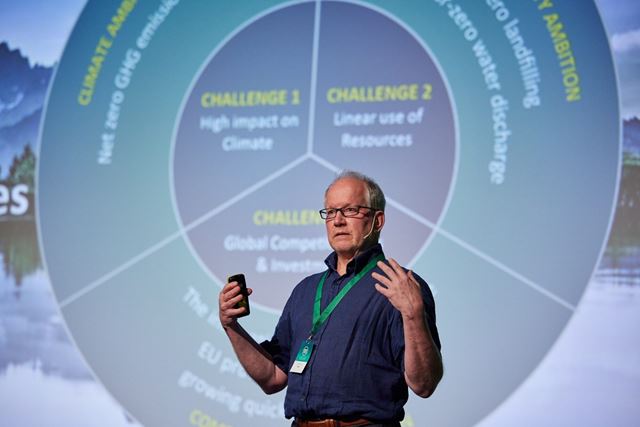“Entire regions and their industries must start adopting circularity by exchanging their materials and energy”.
So says researcher Richard Heyn at SINTEF.
An ‘industrial symbiosis’ is established when different industries operating within a given society exchange energy, materials or waste with the aim of achieving optimal resource exploitation. Examples of resources that can be reused include anything from waste heat and coolant water to critical raw materials.
“If we expand this form of collaboration to incorporate urban areas and regional businesses, we can establish what is termed an ‘industrial-urban symbiosis”, says Heyn. The aim here is to usefully circulate the resources for as long as possible, thus reducing our consumption of non-renewable energy sources and mitigating CO2 emissions.
Well-known symbioses of this type include district heating systems that exploit waste heat obtained from industrial plants. Other examples include companies that collect refractory materials from industrial processes and recycle these as new, usable products.
“Two further examples are the use of ash from combustion plants as a replacement for cement in concrete, or the use of sewage derived from a medium-sized town either as the basis for generating household electricity, or as an industrial raw material”, says Heyn.
The aim of so-called ‘green hubs’ is to gather industrial-urban symbioses on individual sites and at scales large enough that several hundreds of tonnes of materials can flow between the participating industries and other enterprises in society. This enables us to achieve significant reductions in both resource consumption and carbon footprint.

Richard Heyn is a Chief Research Scientist at SINTEF Industry and Vice-Chair for Circularity Innovation at the EU-sponsored Processes4Planet partnership. Photo: Eivind Senneset/Grønn Region Vestland
Towards large-scale application in Europe
The EU is aiming to increase the number of circular green hubs in Europe. This will require not only the scaling up of relevant technological systems to commercial dimensions and rolling them out across the whole of Europe, but also the establishment of innovative and collaborative practices among the different actors involved.
This idea represents the main focus of the EU-funded project Hubs4Circularity Community of Practice.
“The project intends to establish a network for the sharing of knowledge and resources, enabling participating actors to design their processes and arrive in a position where they can implement new technologies as a basis for creating new, circular value chains”, says Heyn.
As part of this Hubs4Circularity project, SINTEF and its partners have developed a digital knowledge platform that offers access to project results and technological systems, as well as the sharing of best practice. Expert groups and advisory panels will offer advice and recommendations to the various participants based on available data and modelling results.
Revolving around the process industries
According to Heyn, the solution that works best for a given hub will vary from community to community. Each separate region will require its own unique system for exchanging energy and material flows.
The project Hubs4Circularity will assist participants to learn from other regions and industrial parks as a basis for identifying the solutions that suit them best.
“Regardless of the solutions that individual regions arrive at, we want activities to revolve around the process industries. In this way, the waste or secondary materials that they generate can be ‘decontaminated’, enabling them to be reused in the manufacture of new products by other industries”, explains Heyn.
More industrial parks
In Norway, the companies Herøya Industripark AS and Mo Industripark AS, as well as the industrial clusters Powered by Telemark and the Eyde Cluster, are already active participants via the Hubs4Circularity project.
“These parks and clusters are already embracing the concept of circularity, but the project intends to expand these initiatives further and will be looking into whether additional symbioses can be exploited”, says Heyn. “We’re also having conversations with Innovation Norway about the possibility of establishing a similar initiative in Vestlandet county and are in contact with other parks that may be interested”, he says.
The aim is to bring together as many into the fold as possible. By making knowledge, experience and best practice accessible via the digital platform, the project researchers are hoping that as many industries and regions as possible will be in a position to participate in green hubs and embrace circularity.
“The knowledge and experience sharing aspects of the project are being designed as we speak, so we’re encouraging all industries, clusters, municipal and county administrations to register on the project’s website at www.h4c-community.eu, says Heyn.



